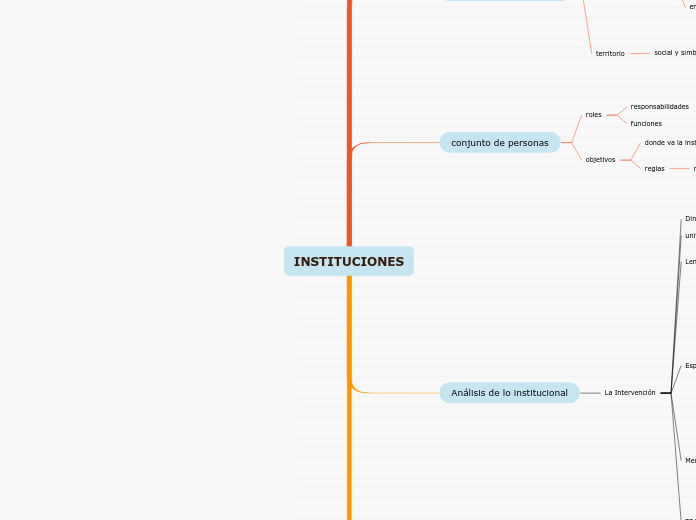av maria laura alamino 4 år siden
343
INSTITUCIONES

av maria laura alamino 4 år siden
343

Mer som dette

To name your story, you have to think about the overall message and what you want your audience to understand from the story. Also, make it relevant and easy to remember.
sistematizacion
evaluación
ejecución
planificación
diagnostico
estudio
practica +teoría
Acción Reflexiva
proceso de intervención
problemáticas sociales
simbólica
lenguaje
cultura
sociedad
practica
contexto
sociohistorico
religión
severidad
manipulación
estabilidad
apoyo
control
sostén
INTERVENCIÓN INDIVIDUAL
Instituido
s. patológico
sujeto pasivo
Filantropia
Disciplina
transformar
profesión
reconstruir la historia
proyectar cambios
no es proceso lineal
experiencias
culturas
vivencias
Representaciones sociales
entender el presente
proyectarme a futuro
aprender lo vivido
es multidireccional
lo Intra/ Entre
dentro y fuera
Observar todo lo social
percepción social
de la institución
instrumento terapéutico
The ending of a story is essential. We all know that if the ending is weak, what happened before loses its importance. So make it unpredictable, but fair. A resolved ending answers all the questions and ties up any loose threads from the plot.
This is the closure section of the story.
See examples of possible outcomes below:
normas
reglamentos
organizan
convivencia
pertenencia
Try answering these questions to come up with a closure:
- Have all the problems been solved?
- Is there a clear picture of what happens with each character in the story?
- Has the challenge transformed your main character?
- How do the characters feel in the end?
This is the moment when the main character surpasses the last obstacle and finally faces their greatest challenge.
The climax usually follows one of these patterns:
Type in your answer.
The middle of the story is where you add layers of complications that will lead to the end. Reveal more about the character's journey. Did their personality go through changes? How did they overcome the challenges? And as you build up the story’s central conflict, make it more personal to that character. Also, from the middle act, you have to lead into the final act.
There wouldn't be any tension and excitement in your story if there weren't any obstacles in your character's way.
A story is nothing more than a character overcoming a series of difficulties to reach the desired goal. Obstacles usually create suspense and conflict. In overcoming obstacles, there is growth: weak becomes strong; hatred turns into love; sadness into happiness; wrong into right; lies into truth; or evil becomes good.
See a few examples below:
comunidad
estigma
opacidad
s. definen
comparten
valores creencias
su identidad
Your character(s) need(s) motivation in order to solve the challenge(s).
Why does your character need to confront this challenge? What does he/she expect to accomplish by solving it?
See a few examples:
Secondary characters also might have motivs beacuse of which they may cross path with main character or which might trigger them to help the main character.
pensar
sentir
actuar
Each story has a main character and that character usually needs to solve a problem or challenge. The character's challenge is the one that creates tension throughout the story.
Type in any other challenges which other characters in the story need to face.
institución
In most stories, there are 3 challenges. The number 3 is a mystical number symbolizing completeness. Try to come up with interesting challenges with which your character needs to struggle.
See a few examples below:
de las personas
que imagen tiene la institución de si
In the beginning of the story (or the exposition), you will need to introduce the setting and characters. You might also want to introduce the main conflict. This part of the story is important because it gives the reader necessary background information and maybe even a first insight into a character’s personality.
la sociedad
regularizaciones
la institución
con el ahora
The setting (time & place) of a story can change throughout the plot.
Sensory details include sight, sound, touch, smell, and taste. These details are important because they create depth in your setting.
See a few examples below:
nuevas normas
I. Burocrática
se rige por pautas, normas reglas
se resuelve
I. Democrática
participación activa
se niega
I.Familiar
se confunden los roles
The weather is an important element in your story because it can highly influence the ambiance and the mood of the characters.
incluyen conocimientos
Decide if you want to include an element of nature in your story. For example, a rainbow can be a very nice choice for a happy ending. The mist in a story can represent mystery and secrets. A thunder can appear in the background at the moment when the 'bad guy' of the story makes its appearance, etc.
The time of the story can also change. It can describe the event of a single day or can include an entire year's plot. Anyway, don't forget to mention it.
psíquicos
predispuestos
físicos
lugar que ocupa
Your story can take place wherever your imagination will take you to.
For example: in an elevator, in an enchanted forest, etc. Don't forget to give details of the environment each time the setting changes, otherwise, the story can be confusing. Also, mention the seasons as each of them has unique weather and events.
se relacionan con
Profesional
efectividad del servicio
trabajan como corresponden?
Administrativa
condiciones de prestación
recursos
La Política
encuadre del servicio
formar ciudadanos
el lugar
Characters are essential to a good story. Usually, the protagonist(s) is/are the most affected by the plot. Introduce a character by focusing on their actions, interests, and occupation, as the physical appearance doesn't make a difference in most cases.
Type in the name of your character.
marca la identidad
Add other qualities/attributes of the character.
identidad especifica
What is your character's main goal?
de relacionarse
Which traits best describe the character's personality? Choose more if necessary:
de ser
Choose the type of your chacter: